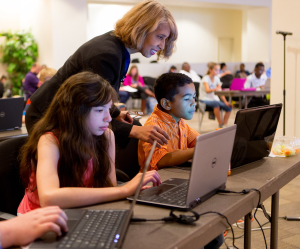Lesson 6 development
Surfing the internet and other computer collocations

Introduction (contextualisation / prior knowledge)
![]() 5 mins
5 mins ![]() Teacher-Learners
Teacher-Learners
Teacher begins the class by writing the following sentences on the board:
1) Yesterday I had ice cream
2) Yesterday I ate ice cream
3) Yesterday I drank ice cream
Teacher asks learners which of these sentences is the most common one(s) and why learners think the other sentence(s) might be wrong.
![]() 5 mins
5 mins ![]() Teacher-Learners
Teacher-Learners
Teacher should explain that a collocation is a combination of words that frequently occur together and draw learners’ attention to the structure of some common everyday expressions (e.g., quick shower, fast food, dark chocolate, strong tea). Teacher should point out that these expressions cannot be said in a different way (e.g., fast shower and quick food would not be a “natural” combination in English).
![]() 5 mins
5 mins ![]() Teacher-Learners
Teacher-Learners
Following that, teacher explains the objectives of the lesson, emphasising the uses of new technological resources for reading and writing technical texts.
Development (SKELL introduction / use of reading techniques)
![]() 15 mins
15 mins ![]() Individual
Individual
Teacher starts the activity and explains that learners will read part of a text that talks about SKELL. After that, teacher asks learners to locate at least 15 cognates in the text through the skim-reading strategy to help them make some predictions/assumptions about what SKELL is. After this discussion, teacher asks learners to answer the Activity 1 questions.
Note: A cognate is a word that has a common origin with another word in the same or different language. They often have similar meaning, spelling, and/or pronunciation. E.g., English “nation” and Spanish “nación” OR English “hope” and German “Hoffnung”.
![]() 5 mins
5 mins ![]() Teacher-Learners
Teacher-Learners
After a few minutes, teacher provides learners with feedback for the previous activities (this part of the class should be ideally done using a computer. If this is not possible, teacher may ask learners to use their mobile phones).
![]() 15 mins
15 mins ![]() Teacher-Learners
Teacher-Learners
Teacher hands out the ‘How it works’ activity sheet and reads the text along with learners. While reading the text, teacher follows the step-by-step on the computer screen.
Development and Application (use SKELL tool)
![]() 15 mins
15 mins ![]() Individual
Individual
Learners do Activity 2. This activity should be done with the teacher’s assistance, who can show learners the use of SKELL in a real time interaction.
![]() 5 mins
5 mins ![]() Teacher-Learners
Teacher-Learners
After a few minutes, teacher provides learners with the right answers for the activity.
![]() 10 mins
10 mins ![]() Individual
Individual
Learners do Activity 3. Teacher acts as a mediator, assisting learners whenever necessary.
![]() 5 mins
5 mins ![]() Teacher-Learners
Teacher-Learners
Teacher provides learners with the correct answers for Activity 3.
Conclusion
![]() 10 mins
10 mins ![]() Teacher-Learners
Teacher-Learners
Walk around the classroom and provide students feedback as/if needed.
Homework
![]() 5 mins
5 mins ![]() Individual
Individual
Teacher hands out the homework handout, in which learners will have to search for some collocations on SkELL and answer the proposed questions using the strategies learned in class.
![]() 5 mins
5 mins ![]() Individual
Individual
Teacher explains the homework and then checks the lesson plan to ensure that all the lesson stages have been completed.
Assessment
Learners’ engagement and participation in the development of the activities carried out throughout the class.

